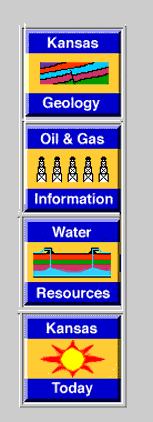by Lee C. Gerhard,
Director and State Geologist

Citizens want to know more about the natural resources and geological processes that affect their lives and livelihood
Scientists generate information that is useful to other people, but sometimes they have difficulty communicating this information to the general public. Research organizations that work in areas that relate directly to people, such as the Kansas Geological Survey, are particularly obligated to communicate effectively. Citizens want to know more about the natural resources and geological processes that affect their lives and livelihood.
The KGS endeavored to increase public communications a few years ago. We developed the Geoscience Data Library as the initial public inoformation access point, providing "one-stop shopping" for geological information. The Survey's Technical Information Services group operates the Geoscience Data Library as well as the Wichita Well Sample Library. The Publications Sales Office distributes topographic maps and geological publications and is a major public contact point. Because of the interaction between these offices, most questions can either be answered directly or forwarded to a qualified member of the Survey staff.
Latest in our efforts to better communicate geological issues to the Kansas public are the Geology Extension program and the KGS Home Page on the World Wide Web. Articles in this issue of the Geologic Record describe the field conferences developed by the Geology Extension program and some of the information available at our Web site. We thank all of you who sent comments, many electronically, about our Internet materials. I welcome comments about any Survey program; they can be sent to me at lee@kgs.ku.edu.

KGS on the World Wide Web

In an attempt to get geologic information out of the file cabinets and into the hands of users, the Kansas Geological Survey has established a home page on the World Wide Web, one of the information networks available on the Internet. Survey publications and data are now available through the home page at http://www.kgs.ku.edu.
More information is being added every day. The gateway to this information is the Survey's home page, recently redesigned by KGS program assistant Dana Adkins-Heljeson, to make it easier to use. A series of buttons gives an overview of the maps, data, and publications available; a click of the mouse takes you where you want to go. Clicking on the "Kansas Geology" button, for example, provides access to several maps of the state. One of these, the Physiographic Map of Kansas, is also available as a postcard from the Survey's Publications Sales office. But unlike the postcard version, this interactive map goes one step further. By clicking on the Smoky Hills region, for example, you get color photos of geological features from that region, in this case of Mushroom Rocks in Ellsworth County and Wildcat Canyon in Trego County.
Information about oil and gas in Kansas can be obtained by clicking on the "Oil and Gas Information" button, which leads to an interactive map of Kansas showing total oil and gas production in 1994. By clicking on any county, you can see detailed data on the oil and gas production for that county. Another tool, currently being developed, is the digital petroleum atlas, which displays geologic and geophysical information as well as data on individual wells and reservoirs.
In addition to data, several KGS publications are now available online, including the 1995–96 Catalog of Publications and the 1994–95 Annual Report. From Sea to Prairie—A Primer of Kansas Geology, a title in the Survey's educational series, has recently been added. And if you're looking for a reference on Kansas geology, the Bibliography of Kansas Geology lets you search a data base of over 14,000 references by author, title, or subject.
Links to other sites on the World Wide Web allow you to check out related (or sometimes unrelated) information from sources outside the Survey. Under "Kansas Today," for example, you can look up information on earthquakes in the U.S., check out current natural gas prices, or even find out the latest weather forecast from the National Weather Service.
Although the KGS web site is relatively new, it's getting some attention–about 5,000 hits per month. "It won't be on the Internet Cool List," says Adkins-Heljeson. "but if you need to look up a stratigraphic section for the Arroyo field in Stanton County, you'll be able to find it."
Online February 10, 2003
Comments to: lbrosius@kgs.ku.edu
Kansas Geological Survey
URL:http://www.kgs.ku.edu/Publications/GeoRecord/1996/vol2.1/Page2.html